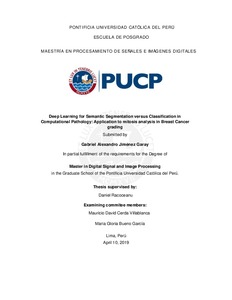| dc.contributor.advisor | Racoceanu, Daniel | |
| dc.contributor.author | Jiménez Garay, Gabriel Alexandro | es_ES |
| dc.date.accessioned | 2019-04-12T17:41:44Z | es_ES |
| dc.date.available | 2019-04-12T17:41:44Z | es_ES |
| dc.date.created | 2019 | es_ES |
| dc.date.issued | 2019-04-12 | es_ES |
| dc.identifier.uri | http://hdl.handle.net/20.500.12404/13969 | |
| dc.description.abstract | Existing computational pathology approaches did not allow, yet, the emergence of effective/efficient computer-aided tools used as a second opinion for pathologists in the daily practice. Focusing on the case of computer-based qualification for breast cancer diagnosis, the present article proposes two deep learning architectures to efficiently and effectively detect and classify mitosis in a histopathological tissue sample. The first method consisted of two parts, entailing a preprocessing of the digital histological image and a free-handcrafted-feature Convolutional Neural Network (CNN) used for binary classification. Results show that the methodology proposed can achieve 95% accuracy in testing with an F1-score of 94.35%, which is higher than the results from the literature using classical image processing techniques and also higher than the approaches using handcrafted features combined with CNNs. The second approach was an end-to-end methodology using semantic segmentation. Results showed that this algorithm can achieve an accuracy higher than 95% in testing and an average Dice index of 0.6 which is higher than the results from the literature using CNNs (0.9 F1-score). Additionally, due to the semantic properties of the deep learning approach, an end-to-end deep learning framework is viable to perform both tasks: detection and classification of mitosis. The results showed the potential of deep learning in the analysis of Whole Slide Images (WSI) and its integration to computer-aided systems. The extension of this work to whole slide images is also addressed in the last two chapters; as well as, some computational key points that are useful when constructing a computer-aided-system inspired by the described technology. | es_ES |
| dc.description.uri | Trabajo de investigación | es_ES |
| dc.language.iso | eng | es_ES |
| dc.publisher | Pontificia Universidad Católica del Perú | es_ES |
| dc.rights | info:eu-repo/semantics/openAccess | es_ES |
| dc.rights.uri | http://creativecommons.org/licenses/by/2.5/pe/ | * |
| dc.subject | Mamas--Cáncer--Diagnóstico | es_ES |
| dc.subject | Cáncer--Diagnóstico por imágenes | es_ES |
| dc.subject | Histología | es_ES |
| dc.title | Deep Learning for Semantic Segmentation versus Classification in Computational Pathology: Application to mitosis analysis in Breast Cancer grading | es_ES |
| dc.type | info:eu-repo/semantics/masterThesis | es_ES |
| thesis.degree.name | Maestro en Procesamiento de Señales e Imágenes Digitales. | es_ES |
| thesis.degree.level | Maestría | es_ES |
| thesis.degree.grantor | Pontificia Universidad Católica del Perú. Escuela de Posgrado | es_ES |
| thesis.degree.discipline | Procesamiento de Señales e Imágenes Digitales | es_ES |
| renati.discipline | 613077 | es_ES |
| renati.level | https://purl.org/pe-repo/renati/level#maestro | es_ES |
| renati.type | http://purl.org/pe-repo/renati/type#trabajoDeInvestigacion | es_ES |
| dc.publisher.country | PE | es_ES |
| dc.subject.ocde | https://purl.org/pe-repo/ocde/ford#2.02.05 | es_ES |






